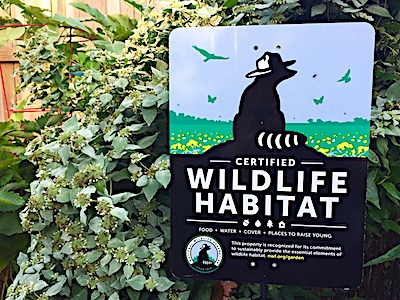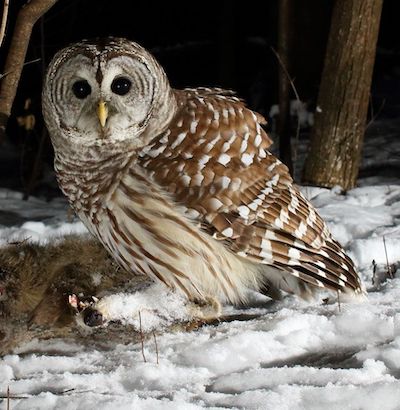Is a Certified Wildlife Habitat in Your Future?
By Carolyn R. Casey, Fairfax Master Gardener
 Do you enjoy attracting and watching birds, pollinators and other forms of wildlife to your yard? Would you like to provide a safe haven in your community for wildlife to co-exist? Then you will want your yard to become a Certified Wildlife Habitat. It is easy, fun and you can even learn how to attract more pollinators and wildlife. I had mine certified several years ago.
Do you enjoy attracting and watching birds, pollinators and other forms of wildlife to your yard? Would you like to provide a safe haven in your community for wildlife to co-exist? Then you will want your yard to become a Certified Wildlife Habitat. It is easy, fun and you can even learn how to attract more pollinators and wildlife. I had mine certified several years ago.
According to the National Wildlife Federation, when a community such as a school becomes a Certified Wildlife Habitat, that school’s name goes into a national database; however, this is not the case with private individuals.
The Backyard Wildlife Habitat program was started by the National Wildlife Federation in 1973. By 1998, it had impacted more than 21,000 yards and as of 2006, has certified over 60,000 backyards. Besides the National Wildlife Federation’s Certification for Wildlife Habitat program, several states have their own certification for wildlife habitat through their own state wildlife federation, and some have teamed up with the National Wildlife Federation when creating their own program.
You can create a welcoming refuge for wildlife with little effort. If you have a yard, a balcony, containers on your deck, a schoolyard, a work landscape or a roadside greenspace, these are all terrific places to create a Certified Wildlife Habitat. You can even purchase a sign that designates your area has been certified by the National Wildlife Federation. The money used to purchase a sign supports the Federation’s programs to protect wildlife and their habitat. You just need to fill out a form explaining how you keep up your yard or garden as a place that provides food and a habitat for wildlife.
In order to have your yard certified, all you have to do is meet a few basic requirements related to attracting wildlife to your yard. Your wildlife garden needs to include food for a diversity of wildlife. This food during the spring, summer and fall months can come from plants and a water source like a birdbath. We empty our birdbath every day to refresh the water, or even more often if need be. During the winter months we have several birdfeeders. We leave the seed heads from our outdoor plants to provide sources of food. I have found that woodpeckers like peanuts, but most of my other birds prefer sunflower seeds. The goldfinches like Nyjer seed, also known as thistle seed, but will only come to the feeders after they have exhausted the seeds from my Echinacea. We also have suet feeders. I planted Monarda to attract hummingbirds, but my annuals continue to attract them after the Monarda has faded.

Heated winter birdbath
A good source of water during the winter months can be your birdbath but you must have an immersion heater to keep the water from freezing. You will also need an outdoor electrical source for your immersion heater and an extension cord. My birdbath in the winter has attracted all kinds of birds. Every year from December to February, the Robins and Cedar Waxwings come to my birdbath and they empty it very quickly, so I have to refill it several times during the day. Also, when the Potomac River freezes we had even more birds come to our birdbath.
You want to have shelters for protection from severe weather and places for the birds and other wildlife attracted to your yard to conceal them from predators or to hunt for food. We have birdhouses throughout the yard. Also when we set up our feeders we make sure that they are near the shrubs and evergreens in our yard. This provides a quick place for the birds to duck into when the hawks come around. The hawks come every year once the feeders are set up. We have even had hawks come and sit on the feeders. We also have planted groundcovers that can be used as a sheltered area.

Barred owl
We enjoy a variety of wildlife. Our fox enjoys lying around and hunting in our backyard. He enjoys eating the mice that like to stay and overwinter in our shed. Sometimes he will catch a squirrel or bird. We find dog toys in our fenced-in backyard that the fox has brought to play with, and we have had the opportunity to watch him play with them. We also have blue-tailed skinks in our yard along with a few black rat snakes and garter snakes. We had a Barred Owl that visited our yard for several years that would come and eat the snakes. It was something to see him come down and catch a snake by spreading his wings out so the snake couldn’t get away and then eating it. Also, our chipmunks enjoy running in our yard and gathering seeds and nuts.
Birdhouses and shrubs not only provide a place of shelter for the birds that visit our yard, but they also provides a safe place for the birds to raise their young. Our fox has had several litters of kits in our backyard. She always runs when we are outside, and we do not feed her. In the spring and summer, she will bring her kits out so we can watch them from our home with binoculars.
The last requirement is that we maintain sustainable practices in our yard. This is where you keep your yard in a very natural environment. Very little pruning keeps our backyard looking natural and makes wildlife feel welcome. Rain barrels catch and retain the rainwater that comes from our roof. We mulch our plants and consult the Virginia Cooperative Extension Pest Management Guide for solutions to plant diseases and insect problems.
This spring, as you are planning your gardens, consider checking out the National Wildlife Habitat or your state’s Wildlife Federation website to see what is required to have your yard certified as a Wildlife Habitat. Who knew that attracting wildlife is certifiable. Happy Gardening!
Resources
Certify Your Habitat to Help Wildlife!, National Wildlife Federation
Certify Your Habitat, The National Wildlife Federation
Certified Wildlife Habitat Application, National Wildlife Federation
Habitat For Wildlife, Virginia Department of Wildlife Resources
Backyard Wildlife Habitat, The Wildlife Center of Virginia
Backyard Wildlife Habitats, Greg Eaton, Barbara Wright, Dave Close, Virginia Cooperative Extension
Habitat for Wildlife, Virginia Department of Wildlife Resources